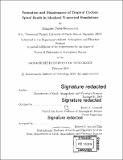Formation and maintenance of tropical cyclone spiral bands in idealized numerical simulations
Author(s)
Perez-Betancourt, Diamilet.
Download1102055097-MIT.pdf (17.38Mb)
Other Contributors
Massachusetts Institute of Technology. Department of Earth, Atmospheric, and Planetary Sciences.
Advisor
Kerry A. Emanuel.
Terms of use
Metadata
Show full item recordAbstract
Spiral bands are one of the most prominent features of tropical cyclones (TCs). These regions of clouds and rainfall are often the source of major TC hazards, such as inland flooding, mudslides, and tornadoes. Since the advent of radar technology, numerous ideas have been proposed to explain the existence of TC spiral bands. Previous hypotheses include the manifestation of atmospheric waves emanating from the TC inner core, boundary layer instabilities, and the interaction between surface cold pools and low-level vertical wind shear. Despite much effort, no consensus has yet been reached on the underlying physical mechanism responsible for TC bands. We approach this problem by examining the formation of TC spiral bands in a set of idealized three-dimensional simulations from the System for Atmospheric Modeling. The simulations are run with doubly-periodic horizontal boundaries, fixed sea surface temperature (300-301K), interactive surface fluxes, and a constant rotation rate corresponding to latitude 15N. No background mean flow is imposed on the TC runs. We find that, in simulations with full moist physics and interactive radiative fluxes, spiral bands are consistently collocated with surface cold pools and aligned normal to the low-level wind shear, similar to tropical squall-lines. However, convection still organizes into spiral bands in simulations in which surface cold pools are supressed. Non-rotating experiments with imposed background wind shear taken from a TC simulation suggest that, in the absence of surface cold pools, vortex dynamics are necessary for convection to align into spiral bands. Finally, we examine numerical simulations of TC-like vortices that develop over a completely dry surface. We find that these dry TCs also exhibit many spiral bands in the wind and temperature fields extending far away from the inner core. Initially, these perturbations are nearly stationary and exhibit overturning circulations consistent with boundary layer instabilities. Barotropic-baroclinic instability dominates the TC structure later in the simulation, reducing the outer region to just a few spiral bands.
Description
Thesis: Ph. D. in Atmospheric Science, Massachusetts Institute of Technology, Department of Earth, Atmospheric, and Planetary Sciences, 2019 Cataloged from PDF version of thesis. Includes bibliographical references (pages 103-114).
Date issued
2019Department
Massachusetts Institute of Technology. Department of Earth, Atmospheric, and Planetary SciencesPublisher
Massachusetts Institute of Technology
Keywords
Earth, Atmospheric, and Planetary Sciences.